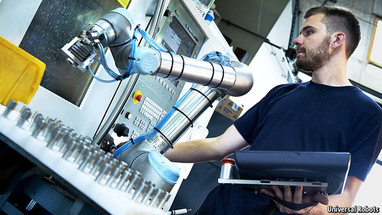May 24th 2017
Collaborative Robots Creating Jobs and Increasing Job Satisfaction
Even for labor-intensive countries like India, the surge in use of collaborative robots is having a positive effect. With the goal of reducing errors, achieving consistent quality, and reducing the workforce in areas of mass production, Indian factories still need human operators for the robots. Some manual processes are still required, which offers the workforce some protection.
Humans must co-exist with innovative technologies. The idea of collaborative robots was introduced in India by Universal Robots, the leading manufacturer of user-friendly, light industrial robot arms. In partnering with nearly a dozen distributors across India, their Industry 4.0 advancements were introduced to the international market.
Perhaps the best advantage to collaborative robots is their ability to take over mundane, repetitive tasks and enable employees to tackle more appealing activities, resulting in a higher job satisfaction rate. Employees are then able to broaden their skills and develop other opportunities. One case of such results was with Aravind Eye Care Systems in Tamil Nadu. By using human-robot collaboration, the company increased production output from 150 to 10,000 Intra Ocular Lenses per day. Use of collaborative robots has complimented their manpower to the degree that the company is now exporting to over 130 countries. The affordable automation has significantly reduced power consumption and quality-control issues, the by-product of which has helped people around the world recover their vision at a reduced cost.
Collaborative robots can also work in conditions that are unsafe for humans. Deploying cobots in industries where abrasive chemicals and elevated temperatures are required can reduce workplace safety risks, making the workplace co-habitable. The robots are also able to take on strenuous jobs that some employees may not be physically able to perform, allowing older workers the ability to work longer and disabled employees a wider variety of opportunities.
Because collaborative robots are less expensive than traditional industrial robots, the ROI is relatively swift. Universal Robots average six months to see a positive return, allowing businesses to reinvest their savings into more technology, training, research and innovative products.
Another key benefit of collaborative robots is their ease of use and ability to work alongside humans without safety fencing. Employees report positive emotional responses to working with the robot and feeling a sense of pride in their ability to operate it without extended, specialized training.
Employees with more challenging projects tend to report higher job satisfaction rates than those with more tedious, mundane jobs. This positive outlook toward the work can reduce workforce turnover and save in hiring costs, not to mention increase productivity of existing workers.
A study conducted by MIT researcher Julie Shah at the BMW plant shows that human-robot teams work more efficiently and achieved a higher level of precision and productivity compared to teams of all humans or all cobots. She has observed that collaborative teams reduced the time the humans were idle by 85% and that the human workers accepted the robots leading their tasks.
The International Federation of Robotics, which has studied the contribution of robots to productivity, estimates that robot-driven tasks will account for approximately 10% of total GDP growth over the next 14 years. It has also forecasted that growth from increased automation will result in an annual increase of 1.4% over the next 50 years.
While the demand for highly-skilled, higher-paid employees appears to be growing in areas of automation, the effect on the less skilled, lower-paid workforce remains cloudy. With the reliable benefits of increased productivity, greater competitiveness, and producing better quality products with fewer workers, automation will continue to grow. Governments and private institutions will be required to work in tandem to achieve the greatest benefits of automation improvements. Research shows a cooperative outlook between humans and advanced manufacturing technology will bring the greatest benefit in the next industrial revolution.

